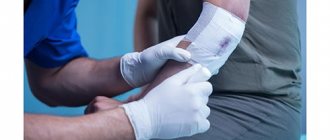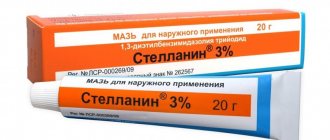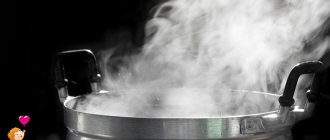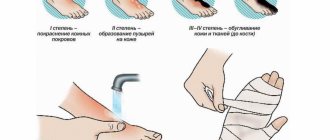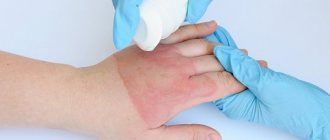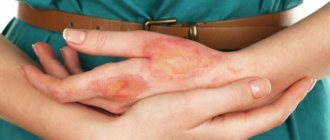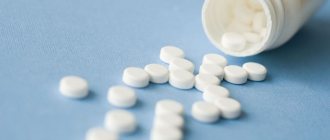A burn is one of the types of injuries in which damage and destruction of the skin and soft tissue occurs. The reasons may be different: high temperature, electric current, aggressive chemical compounds, sun rays. A person can receive such an injury anywhere: at home and at work, on vacation and in any other place.
The number of deaths and people with serious injuries could be reduced if everyone knew how to provide first aid in a timely and professional manner. Specialists from the multidisciplinary medical center KIT recommend that you familiarize yourself with the rules for providing care for burns. We advise you to follow safety rules and remember well what needs to be done in such cases and what is strictly prohibited.
General actions for burns
Most often, people suffer from burns caused by open fire, hot objects, or boiling water (thermal). However, there are also types of burns such as electrical (from electric shock), chemical (from acid, alkali), and radiation (from the sun). To begin with, we will list the general procedure that must be followed for any burn.
- Stop the effect of the negative factor: extinguish burning clothes, turn off the power supply, etc.
- Specify the type of burn, and, if possible, determine its area and degree. To determine the area, use the “rule of nines”:
- palm, genitals - 1% each,
- arm, chest on both sides - 9% each,
- leg - 18%.
Degrees: I - redness and swelling, II - blisters with transparent contents, III - necrosis of layers with the formation of a dense scab, IV - charring of tissues. - In severe cases, immediately take the victim to a medical facility or call "emergency".
- In case of minor injury, the burn area can be watered with cool water for 10-15 minutes. In case of extensive burns, this should not be done.
- Cut the clothing around the injured area; if any remains are stuck to the wound, leave them alone. Apply an aseptic gauze bandage around the burn. Do not use cotton wool for this.
- If your fingers are affected, cover them with gauze or a bandage. It is better to immediately remove rings and other jewelry from your hand before swelling occurs.
- Fix the burned part of the body, make sure that it is on top, preferably above the level of the heart.
- Give the victim a pain reliever and antihistamine. If there is no vomiting, provide him with plenty of fluids. Mineral water without gas or plain water with 1 tsp will do. salt and ½ tsp. soda per 1 liter.
Position the patient so that the burned areas are stretched as much as possible.
Remedies for burns
Today, there are many types of medications for burns in the form of gels, ointments, sprays, creams and dressings.
For example, Levomekol helps well with thermal burns. The drug has bactericidal properties, thanks to which the injury heals much faster. Moreover, the constituent components are substances that help relieve pain.
Povidone-iodine ointment contains iodine. The chemical element disinfects the site of damage and promotes the rapid restoration of skin tissue. Balm Rescuer, made from natural ingredients, can restore damaged skin to a healthy appearance in the shortest possible time.
The creams have also actively proven themselves in the treatment of burns, which are used at the recovery stage of damaged tissue areas. They can be used for preventive purposes against the formation of scars. Panthenol cream helps well with thermal and sunburn.
First aid for various types of burns
The algorithm of actions may vary depending on the cause of the burn. Let's look at the most common options.
Boiling water/steam burn
Such a burn is usually not severe (I–II degree). Here's how you can help the victim:
- Eliminate the damaging factor.
- Cool the burn area with running water.
- Cover it with a damp gauze/cloth bandage.
Absolutely forbidden:
- apply ointment, oil, fatty sour cream (they contribute to the spread of infection);
- apply snow, ice;
- tear off stuck fabric;
- puncture blisters that appear on the skin.
Burn from boiling oil
As a rule, drops of oil leave a small area, but quite deep 1-2 degree burn. It needs to be cooled with a stream of cool tap water, and then consult a doctor. There is no need to treat the wound with anything.
Burn from an iron or a hot object
Typically, thermal burns have degrees II–IV severity. The victim is provided with the following assistance:
- Place the wound under running water for 10-15 minutes.
- Apply a dry bandage to it.
- If necessary, consult a doctor.
No need:
- Apply ice.
- Apply oil, ointment.
- Use other folk remedies.
Electrical burn
Typically, such burns are small in area (they are noticeable only at the points where the electrical discharge enters and exits), but they are very deep. You need to do this:
- Turn off the electrical source.
- Call an ambulance.
Forbidden:
- touch the victim before the power source is turned off;
- lubricate the burns with something.
Chemical burn
Caustic alkalis, vinegar essence, undiluted hydrogen peroxide, and various industrial compounds can cause burns. In this case, you need to do the following:
- Rinse the wound with cold water for 15-20 minutes.
- Neutralize the chemical. For a burn caused by acid, sprinkle with baking soda or wash with soap and water. Treat alkali burns with diluted vinegar.
- Apply a sterile gauze/cloth dressing.
In no case:
- Do not touch the affected area, as the chemical, even after superficial removal, partially remains in the deep layers and can continue to negatively affect the tissue.
- Do not apply compresses to the sore spot.
Sunburn
Such a burn is a very common injury at resorts among those who strive to get a beautiful tan in the shortest possible time. The injuries are not severe (grade 1-2), you can help the victim yourself as follows:
- Take the person to a cooler place, in the shade.
- Apply a bandage soaked in cool water to the red areas.
- Invite the patient to take a cold shower/bath.
- In case of dizziness or nausea, you should call a doctor, as the victim may have heatstroke.
Prohibited:
- Use ice to cool/treat skin.
- Wash burned areas with soap, scrub, or rough washcloth.
- Apply alcohol solutions to the burn, as they additionally dehydrate the skin.
- Apply petroleum jelly, oils, and fat to the wound, as they cause clogging of pores.
- Sunbathe, stay in the sun until the person recovers.
- Drink tea, coffee, alcohol, as these drinks dehydrate the body.
Hogweed burn
This plant is widespread in most regions of Russia, including Krasnoyarsk. It secretes toxic juice, which can enhance the effects of the sun several times. One drop is enough to cause a 2nd degree burn. If juice gets on your skin, do the following:
- Wash the burn with soap and water and sprinkle with baking soda.
- In case of fever, headache or allergies, consult your doctor.
It is forbidden:
- Continue to stay in the sun after hogweed juice has come into contact with your skin.
- Lubricate or rub something into the skin.
We looked at the most common types of burns. We hope you have learned the simple rules of first aid. Remember that at the KIT multidisciplinary medical center you will be provided with comprehensive support and advice on treatment and recovery after burns. You can ask our traumatologist all questions.
What is a first degree burn?
A first degree burn is a mild injury. It is characterized by redness of the skin, slight swelling, and mild pain. The temperature may rise locally. With a 1st degree burn, only the upper layers of the epidermis are affected, and the deeper layers of the skin and subcutaneous fatty tissue are not affected.
After providing primary medical aid (first aid), such burns heal without a trace within a few days in adults and a little longer in children. But to prevent a minor injury from growing into a big problem, you need to know what to do in case of a 1st degree burn, and how to properly provide first aid.
Bandage removal procedure
The instructions for the burn wound patch contain general recommendations on the frequency of dressings. Considering that in each case the damage is individual, it is advisable to obtain the advice of a doctor. For minor superficial damage, dressings are usually done once every 2 days, unless there is excessive wetting and slipping. Serious injuries are treated twice a day, with the exception of the use of special dressings, the action of which is prolonged. They are changed once a day or as the doctor says. After a few days, a specialist will assess the condition of the wound, and if healing is going well, dressings are done less frequently - once every 3 days.
Dressings should be removed carefully. The average healing time for moderate burns is 2 weeks. If the wound does not heal by this time, the condition worsens and you need to urgently visit a doctor and treat the burn in a hospital.
What to do if a blister forms?
Treatment of skin with such an injury includes rinsing and applying a loose bandage to prevent microbial contamination. When blisters appear, during the first two days the burn is purulent-necrotic in nature. The fluid inside the blisters becomes cloudy, and the surrounding tissue becomes inflamed. Every 4 hours, the bandage is changed and moistened with antiseptic solutions so that it does not dry out to the skin. Opening the fluid capsule may result in a lengthy healing process.
Large blisters are best treated in a hospital setting. A visit to the doctor will be mandatory if they fester and cause severe pain. Another symptom of infection will be an increase in body temperature. Opening the bladder must be carried out under sterile conditions.
Diagnostic measures
Before treating a 2nd degree burn, it is necessary to assess the extent and depth of tissue damage. You should definitely consult a doctor in the following situations:
- More than 5% of the skin surface is affected (in children - more than 2%).
- Localization - on the face or perineum, or the respiratory tract and esophagus are affected.
- The pain only gets worse over time.
- Swelling appears and foci of suppuration develop.
With a 2nd degree burn, bubbles with transparent contents usually appear. To determine the affected area, use the palm rule, the essence of which is that the area of the palm is counted as 1%. Based on this, they determine how much the affected area has spread and decide whether hospitalization is necessary. Even with a small degree of burn, but a significant area of damage, there is a risk of painful shock.
Is it possible to lubricate burns with brilliant green and iodine?
Zelenka and iodine are the first things that come to mind when it comes to what to apply to burns. However, this should not be done; in rare cases, you can carefully apply a small amount only around the wound itself. Consequences of using iodine and brilliant green:
- chemical burn;
- pain;
- burning;
- blisters.
The action of iodine and brilliant green solutions only aggravates the resulting damage from boiling water. They also slow down the regeneration process in case of burns. These products should not be used by people with allergies.
Contraindications to deep peeling
Deep skin peeling is not recommended for people with dark skin. A chemical burn leads to disruption of the production of melanin pigment in the affected area, as a result of which the renewed and rejuvenated skin will be noticeably paler than in other parts of the body. This will reduce the aesthetic value of the anti-aging procedure.
Deep peeling is contraindicated for persons with inflammatory reactions on the skin of autoimmune, allergic or infectious origin, diseases of the hepatobiliary system and kidneys, oncopathology, diabetes mellitus. Phenolic peeling is not performed during pregnancy and lactation. Individual intolerance to the drug and allergies are also contraindications for the procedure.
How to determine if a burn wound is infected
Very often, burn injuries to the fingers are accompanied by the formation of blisters, which are the main causes of infection and the development of inflammatory processes. The risks of such phenomena are especially high in cases of intentional or accidental opening of bubbles.
If an infection is associated with the injury, this can be determined by the following signs:
- the victim feels throbbing or acute pain, the intensity of which increases every day;
- increased body temperature;
- severe redness of the skin, which does not go away even after applying special antiseptics;
- observation of purulent discharge.
In most cases, infectious processes occur due to dirt, dust and other contaminants getting into wounds. That is why it is impossible to open the bubbles prematurely and on your own.
Treatment at home
If you burn your fingers with boiling water, it is recommended to immediately immerse them in cold water. This will stop the negative thermal effects.
ethnoscience
Do not use any oily substances on a fresh burn. For superficial burns, a compress of calendula oil can be applied on the second or third day. The herb has a strong antiseptic and wound healing effect.
Soak the bandage with aloe juice.
When applying a bandage, you can pre-soak it with the juice of aloe, golden mustache or plantain. These plants include tannins and flavonoids, which accelerate tissue regeneration.
Ice is not used in healing therapy. Blood circulation in injured tissues is impaired, and exposure to extreme cold aggravates the situation. Also, pure iodine, which has a warming effect, is not suitable for processing.
Any bandage should not be tight so that a film is not created on the surface of the finger burn. If you follow the recommendations and there is no infection, recovery from a superficial burn occurs within a week.
Drug therapy
Panthenol normalizes cell turgor and restores their structure.
Special ointments will help speed up healing. But they can be applied no earlier than two hours after the injury. Most drugs contain panthenol, which normalizes cell turgor and restores their structure. For more severe burns, use Levomekol. It is also permissible to use pain-relieving ointments, for example, Ketonal. But if blisters appear, it is better to use oral analgesics.
Using ice
It is possible to relieve pain from a burn at home using ice. The main thing is to perform the procedure correctly so as not to get frostbite. The ice itself or other cooled object should be wrapped in cloth, and the application time should not exceed 5-7 minutes. Otherwise, it will not be possible to alleviate the unpleasant symptoms. Plus, exceeding the permissible time period will lead to the death of the upper layers of the epithelium and other pathologies.
Special topical medications help relieve pain after a burn. Their timely application will determine how quickly relief and subsequent recovery will occur.
Prevention of household burns
Anyone can suffer from thermal skin damage. Most often, such cases are observed in the kitchen during the cooking process. Any careless movement can lead to spilling boiling soup on yourself and other unpleasant situations. Therefore, when performing daily household work, you should be extremely careful so as not to encounter situations of “burned fingers, what to do and how to treat.”
To prevent burns, you need to follow a few very simple rules:
- When preparing dishes on the stove or in the oven, do not grab hot pots, baking sheets, frying pans and other utensils with unprotected hands. To do this, you need to use special gloves or towels;
- do not leave pots with just cooked hot dishes on the edge of the stove or table, so as not to accidentally knock them over on yourself;
- carefully and carefully open the oven in which the dish is being prepared. The hot steam accumulated in it can burn not only the fingers, but also other parts of the body;
- do not work without gloves with chemicals used to wash sinks, toilets, tiles or stoves;
- do not leave electrical appliances on: irons, curling irons, soldering irons and others;
- do not smoke in bed, as this can lead to dire consequences.
It is an undeniable fact that it is much easier to prevent a burn to the fingers than to treat it and experience severe pain and discomfort. Therefore, you should never forget that following generally accepted safety measures will help maintain your health.
If, due to your own negligence or for other reasons, you have a burn to your toes or hands, then even with minimal damage you should not neglect timely treatment. Adequate therapy will relieve severe pain and burning. But when using medications or remedies prepared according to folk recipes, it is necessary to take into account the degree of damage to the skin and use them in strict accordance with the instructions.
Clinical researches
The conducted clinical study proves the high efficiency, safety and tolerability of products for daily skin care of children with mild and moderate forms of atopic dermatitis and during remission, accompanied by a decrease in the quality of life of patients. As a result of therapy, a decrease in the activity of the inflammatory process, a decrease in dryness, itching and flaking was noted.
The properties of the products are confirmed by a clinical study conducted jointly with the St. Petersburg Union of Pediatricians of Russia.
It has been proven that the cream for sensitive skin reduces itching and irritation, relieves redness, moisturizes and gently cares for the skin.
Sources:
- Skin diseases of newborns and infants. Guide for doctors / Gorlanov I. A., Leina L. M., Milyavskaya I. R., Zaslavsky D. V. St. Petersburg: Folio. 2016.-208 p.
- Kovyazina N.A., Fedosimova N.A., Illek Ya. Yu. Diagnosis of atopic dermatitis in young children, Vyatka Medical Bulletin, 2007
- Smirnova G.I. Managing the course of the disease: atopic dermatitis in children, Russian pediatric journal, 2014
How to avoid complications and improve wound healing?
The main complication may be burn disease. It develops when more than 5–10% of the total skin area is affected. The complication arises due to a complex malfunction of organs and systems. We are talking about tachycardia, poor circulation, intoxication and other pathological conditions. It is important to contact the burn department in time, where specialists will eliminate pain, normalize breathing, and prevent kidney and cardiovascular failure.
Another complication of burn injuries is sepsis. To avoid infection, you need to use only specialized plasters on burns and only as prescribed by a doctor when it comes to serious injuries. Regular treatment, monitoring the condition of the wound and the healing process is what is required during treatment to avoid complications.
